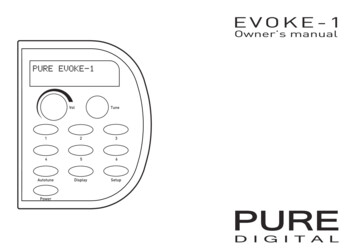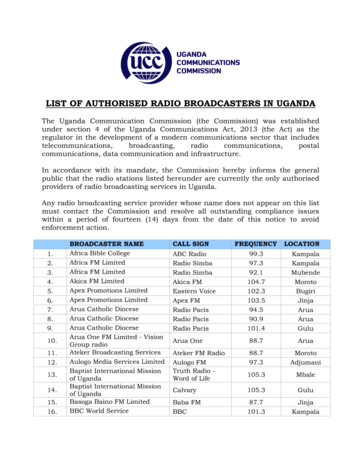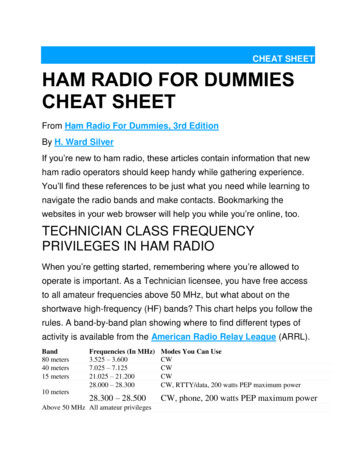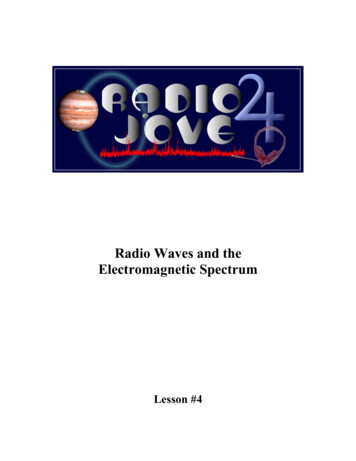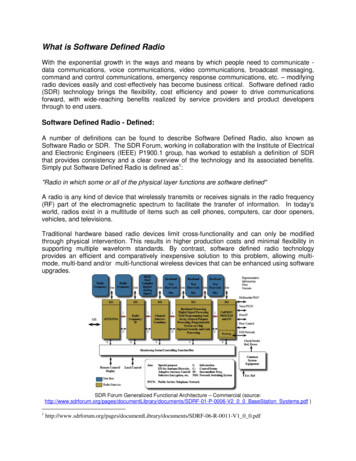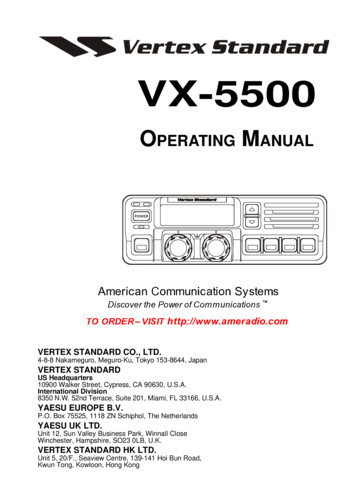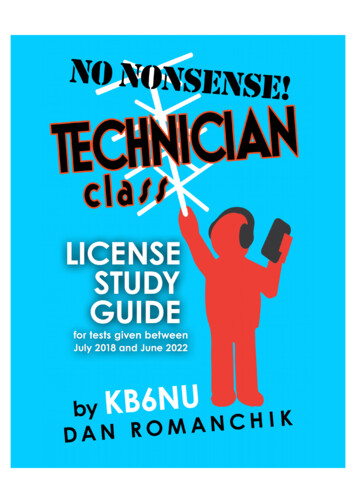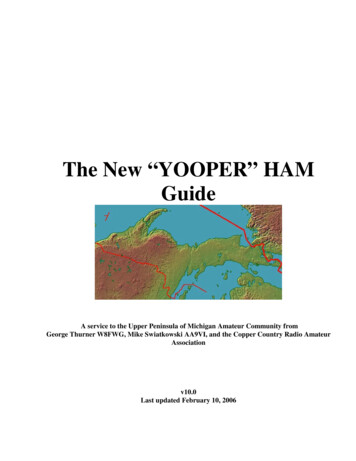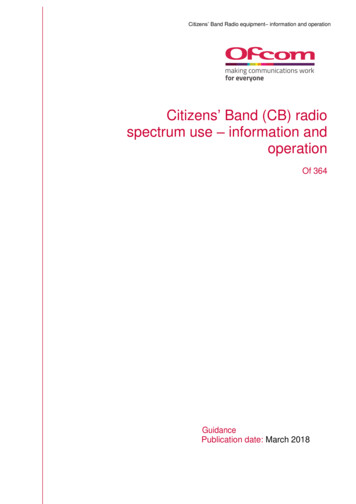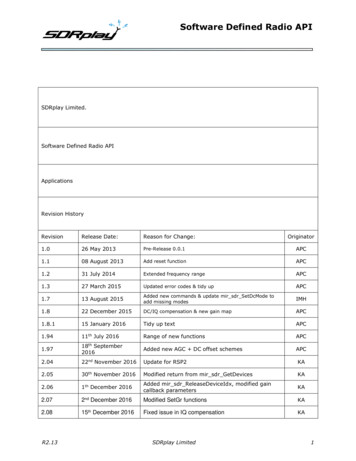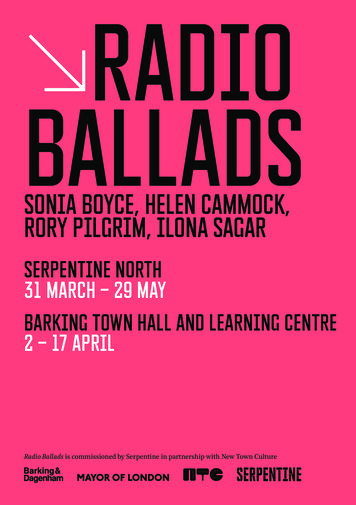
Transcription
RadioBalladsSonia Boyce, Helen Cammock,Rory Pilgrim, Ilona SagarSerpentine North31 March – 29 MayBarking Town Hall and Learning Centre2 – 17 AprilRadio Ballads is commissioned by Serpentine in partnership with New Town Culture
INTRODUCTIONWhat are the sounds of care, and how do we listenand hold them?Sonia Boyce, Yes, I Hear You, Production Still, 2021. Photo: Matthew Ritson.Rory Pilgrim, I connect with people in my dreams, Sketch, 2020.Radio Ballads, showing simultaneously at Serpentineand the London Borough of Barking and Dagenham(LBBD), shares a series of collaborative commissionswhich explore stories about labour and who caresfor whom, and in what way. Over the past threeyears, artists Sonia Boyce, Helen Cammock, RoryPilgrim, and Ilona Sagar have collaborated withsocial workers, carers, organisers, and communitiesacross LBBD. Four films and bodies of research haveemerged from these long-term artistic processes.Building on Serpentine’s ongoing criticalinvestigation of the role of artists in political andcivic life, Radio Ballads asks how art practices canbecome part of systemic transformation. Theproject is also part of LBBD’s New Town Cultureprogramme: a ground-breaking initiative thataims to embed artists within core social careservices and explores how artistic processes canreframe the work of social care.
AN INVITATION TO TAKE CARESHARED STORIES, SHARED SONGSThis invitation to care was developed throughguidance from Meenadchi, a DecolonisingNon-Violent Communication educator andFamily Constellations facilitator.Radio Ballads asks how we can again start tounderstand, listen, learn, and heal throughcollective storytelling. In a time of multiple crises,the project explores how voices – individual andcollective – can illuminate structures of care andallow us to reflect on conditions of life and theeffects of labour in our communities. Singing hastransformed the experience of work and changesince history began – but what kind of collectivesongs are needed now? Developed through years ofThe works in this exhibition explore vulnerabilityand brave resilience often in the face of deep painand difficulty. It may awaken your own needs forcare and courage in the context of journeys youhave experienced, navigated, or witnessed. Weencourage you to honour these needs as we shareand celebrate this work together. This could looklike: taking a deep breath; pausing to drink water;finding a comforting colour to focus on; steppingoutside to sit on the benches at the front of theSerpentine North gallery; sitting in the rest zonein The Magazine restaurant; taking a walk in thepark or Barking Town Square. You can also find agrounding exercise at the end of this guide to helporientate yourself within the exhibition orafterwards.Ballads can describe poems or narratives set tosong, which were traditionally passed on fromperson to person, meaning they were usuallychangeable and lost individual authorship.Emerging in medieval Europe, for centuriesballads were a primary and highly accessiblesource of information, sharing newsworthy eventsacross divisions of class, education, gender, andage. Ballads were closely linked to the process ofgrieving and sharing grief publicly. They wereusually written or performed in the first-person,offering a framework for their singers to interpretthe world around them.
relationship-building, and the generosity of manycollaborators, the works in Radio Ballads featurethe voices of the people whose work and care keepsmany of us afloat.LINEAGES OF LISTENINGRadio Ballads takes its name from a revolutionaryseries of radio programmes, broadcast on the BBCfrom 1957-64: a time of rapid change across theUK. Created by Ewan MacColl, Peggy Seeger, andCharles Parker, these eight programmes combinedsong, music and sound effects with the stories ofcommunities. Each original Ballad focussed on thelived experiences and resistance of workers andgroups whose voices were rarely or never heard inthe media. The four new Radio Balladscommissions build on this history. Produced inthe wake of twelve years of austerity and amid theongoing dismantling of the UK care sector, theprojects were sustained through multiple nationaland global crises, and against the backdrop ofcontinued systemic racism and ableism.The urgency of the stories within Radio Ballads hasonly increased as the COVID-19 pandemiccompounded social inequity and underlined howthose who do the work of care are oftenundervalued and insufficiently supported.Centring the voices and experiences of social careworkers – and of people receiving and giving carethrough more informal networks – the artworksin the Radio Ballads exhibition share complex andintimate stories of living and working in ourcurrent moment.Presented in a time of ongoing recovery, RadioBallads considers how artistic practices, andcreating space for imagination and joy, can supportpeople to reflect on and process differentexperiences, including social care, mental health,domestic abuse, terminal illness, end of life care,and loss. The four projects work with questions ofwhat resources we need and what keeps usconnected. Radio Ballads listens to testimonies;reflects on complex issues involving trauma,accountability and systems that perpetuate harm;and contemplates new possibilities for us tonavigate the future together with care.
Each project draws on the methods andtechnologies used in the original Radio Ballads;listening deeply to the testimony of those withlived experience, discerning different registersand qualities of voice, collaborative songwritingand storytelling, and techniques of audio stitchingor montage.Rory Pilgrim, RAFTS workshop with Green Shoes Arts and Project Well Being, October 2020
YES, I HEAR YOUSONIA BOYCEOnly by listening to the stories of those who haveexperienced domestic abuse can we achieve changein how those affected are heard and supported.Sonia Boyce’s Yes, I Hear You is underpinned byprocesses of sharing testimony and engaging indeep listening, asking how different people andsystems witness complexity in interpersonalrelationships. Presented as a four-channel videoinstallation accompanied by eight digital printsand wallpaper, Yes, I Hear You is the culmination oftwo years of research involving interviews,workshops, reviews, and performative sessionswith people who identify as survivors of domesticabuse; those who have perpetrated harm; and careworkers, harm reduction facilitators, andtherapists who support people directly affected bydomestic abuse.Sonia Boyce, Yes, I Hear You, Production Still, 2021. Photo by Matthew Ritson.
An essential part of Sonia Boyce’s artistic processis gathering a variety of people to help conjuresomething tangible out of the immateriality of aconversation. The framework of the project wasinformed, as it evolved, by careful reflection oncomplex issues involving relationship dynamics,trauma, accountability, and the systems thatperpetuate harm.cases of abuse. The work emphasises the impact ofspeaking out and asks viewers to listen deeply andbecome witnesses.Film performers are Michelle Hamilton, Luke Christian,Jasmine Butterfly, and Amelia Grant.Project partners are LBBD Domestic Abuse CommissionFor Yes, I Hear You, Boyce invited groups of people,from social workers to academics, to listen toanonymised transcripts of people who had sharedtheir experiences of coercive behaviour and abusewith the artist. Boyce later invited the four filmperformers to interpret these transcripts as well,connecting with their own responses. Throughoutthe project, Boyce and her collaborators asked whowe listen as and who are we listening to, and whathappens to stories of harm through acts ofcollective voicing, recording, and embodiment.and Survivors Panel, LBBD Social Care Services, andClean Break.Thanks to all project collaborators: Kat Acevedo,Cllr Samia Ashraf, Sammy Holcombe, Anna Graham,Nathan Roser, Kayleigh Tumber, Zahra Ibrahim,Ain Bailey, Sarah Boosey, Susan Cade, Georgia Scotland,Petra Prince, Maria Cripps, Florence Henry, AnnaHerrmann, Rachel Hughes, Claire Pounder, Gail Lewis,Róisín McBrinn, Michelle Hamilton, Luke Christian,Jasmine Butterfly, Amelia Grant, Adam Young, JosephKaranja, Christine McGeary, Maria Clerkin, ToluAs the performers stand on stage in the film, Yes, IHear You, the juxtaposition of their smiling veneerwith the spoken stories that we hear underscoresthe discrepancies between public and private inWilliams, Dana Janes, Diane Calverly, Cranstoun, LatifatAfolabi, Polly Neate, Cllr Maureen Worby, Hazel NorthStephens, Faye Gayle, Niamh Sullivan, We Rise Hub andExcel Women's Centre.
BASS NOTES AND SITELINES:THE VOICE AS A SITE OFRESISTANCE AND THE BODY ASA SITE OF RESILIENCEHELEN CAMMOCKHelen Cammock, Bass Notes and SiteLines: The Voice as a Site of Resistance and The Body as a Site of Resilience,Production Still, 2022“I’m interested in how resistance and resiliencecan be shared by people but be presented indifferent ways, and how they can be readdifferently because of a person’s experience,context and subject position.”Artist Helen Cammock is interested in whatresistance and resilience look and feel like, and therelationship between them. For Bass Notes andSiteLines, she asks how we use our bodies andvoices to articulate what we feel, and how awarewe are of these performances – both in a specificmoment and throughout our lives.Helen Cammock, Bass Notes and SiteLines: The Voice as a Site of Resistance and The Body as a Site of Resilience,Production Still, 2022
As a former social worker, Cammock is consciousof the deep responsibilities that these workers holdfor others, and the impact that this can have inpeople’s lives. Through sessions with both peoplereceiving care and those who offer it through adultsocial care work and an organisation called Pause,Cammock explored these ideas and others usingdrawing, photography, film, and song. In theircollaborative workshops, the groups sang together,considered gesture as a way to communicatethrough the body, and explored their connectionsthrough music and lyric writing – reflecting onhow the voice can shift registers to express pain,joy, rage, and care, whether alone or surroundedand supported by other voices.voice and body can come together to offer forms ofcare and demonstrate resistance and resilience.Project partners are Pause, LBBD Adult Social CareServices, and InJOY Choir.Thanks to all project collaborators: Tia Rose, CharlotteMarshall-Vale, Claire Martin, Amelia Grant, Amy Pope,Lois Otu Enwo, Paula Robinson, Petra Prince, SusanCade, Georgia Scotland, Sarah Boosey, Aleecha, Jasmine,Lucy, Kellyanne, Sarah, Paige, Shannon, Kirsty, Deanna,Claire, Danielle, Gemma, Stacey, Wendy Pickles, SandraCammock, Tish Marble, Tamsin Hinton-Smith, SamGriffiths, Georgia Barrington, Tracey Hayward, JoanneVaughan, Sarah Foord and LBBD Community Solutions.For the Radio Ballads exhibition, Cammock hasshared the process of developing this project bypresenting a film, a fabric banner, a reading tableof reference materials, group drawings createdthrough meditation exercises, and a live voiceperformance composed through collaborativesongwriting and singing sessions. ThroughoutBass Notes and SiteLines, Cammock and hercollaborators explored the ways in which text,Project Assistant: Becky WarnockSinging Facilitator and Singing Group Leader:Katie Slaymaker
RAFTSRORY PILGRIMIn moments of change and transition, whatsupports us and keeps us afloat? A raft is thesimplest and most fragile vehicle of survival onopen water. Ancient as human language, rafts arestill needed during urgent crossings. From theAbrahamic story of Noah’s Arc to the idea ofEarth as a lonely life raft floating in space, thesymbol of a raft has often represented theultimate preserver of life.Amid the COVID-19 pandemic, artist and composerRory Pilgrim developed RAFTS as the secondchapter in a body of performance, film and sonicwork exploring how the climate crisis relates tosupport structures in our everyday lives. Thecommission is narrated by the voices of eightresidents of Barking and Dagenham from GreenShoes Arts: Hugh, Carina, Liam, Butterfly, Katy,Dee, Mark, and Eddie, who each in their own wayreflect on what the symbol of a raft means to them.Rory Pilgrim, RAFTS, Green Shoes. Photo by Jessica Emovon.
mark time and act to enable support and preventharm in both the short- and long-term. Using toolsof prophecy, reflection and creativity, the concerttakes us on a journey that contemplates which‘rafts’ could be needed to navigate the future intimes of change and uncertainty.Alongside the film, Pilgrim and collaborators areshowing paintings, drawings and specially-madeobjects that share visual and embodied tools forbuilding personal rafts.Rory Pilgrim, Rafts, Oil and Nail Polish on Board, 2020. Courtesy of Andriesse-Eyck Galerie.At the heart of RAFTS is a concert broadcast thatinterweaves stories, poetry and reflections arounda seven-song oratorio that makes connectionsbetween work, mental health, home, recovery, andour environment. Further voices and people fromnear and far join the journey, including members ofBarking and Dagenham Youth Dance, members ofProject Well Being – a group for those experiencinghomelessness in Idaho, USA – and solo singersDeclan Rowe John, Robyn Haddon and KaydenFearon. Inspired by the original Radio Ballads asvessels of time, the RAFTS concert explores how weProject partners are Green Shoes Arts, Barking andDagenham Youth Dance, Project Well Being (InterfaithSanctuary, Boise, Idaho) and London ContemporaryOrchestra.Thanks to all project collaborators: Eddie Paggett, HughPrior, Dee Pessoa, Carina Murray, Liam O Connell, MarkJones, Emily Butterfly Khoury, Catherina Rowland, VickiBusfield, Sam Miller, Nikki Watson, Kevin Walton,Melissa Bell, Marcos Ramos, Geoffrey McCauley, JanetKauffman, Nicki Vogel, Jeffrey Doroto, Jacob Heiter, TinaLogsdon, Tina Cartwright, Scott Cramer, Sarah Kemper
Cook, Georgina Alexiou, Red Fox, Anabel Berko, BreannaAmoako, Calum Johnstone, Chisom Nzekwe, EugeniaRapta, Heavenly-Joy Obeng, Kiera Dymond, Lara PintoWlodarczyk, Marly Fadiga, Rome Martin-Whilby, RubyHarris, Sasha Dilevska, Kayden Fearon, Robyn Haddon,Declan Rowe John, Rob Ames, Saloni Thakkar, AmyHinds, Jack Sheen, Marged Sion, Paul Perry, Donna Cain,Lorraine Fox, Salom Ranger, LBBD Temporary Housingand Accommodation, Ronald Long, Natasha Humphries,Freya Hicks, Rebecca Burden, Clare Bennett, AlastairPenman, Anna Drysdale, Todd Harris, Rick Leigh, DavidJarzen, Dan Lewis, Letty Pilgrim, Kate Marlais, KatieDove Dixon, Seraphina Simone D'Arby, Sophie Galpin,ASAI, Jonathon Graham, Olga Micińska and MathildClerc-Verhoeven, Cody G, Charlie Gregory, Dave andThe White House.Rory Pilgrim, RAFTS, Barking and Dagenham Youth Dance, Production Still, 2021. Photo by Matthew Ritson.
THE BODY BLOWILONA SAGARDue to the presence of docks and heavy industries,Barking and Dagenham has the highest level ofasbestos-related cancers and mesothelioma inLondon. The Body Blow is a two-channel film workdeveloped through Ilona Sagar’s long-term researchand collaboration with people with lived experienceof these diseases, London Asbestos SupportAwareness Group (LASAG), social workers, end-oflife carers, asbestos removal experts, campaigners,and medical and legal professionals. The Body Blowtakes its name from the only original Radio Balladwhich focussed on an absence of work by voicingthe experiences of people paralysed by polio.Considering ideas of ‘acceptable bodily risk’, thefilm asks what risk means in the context of care,work and health.Asbestos is considered a historical concern, but itstill has devastating effects today and is etchedalarmingly on to our future. Carcinogenic fibresIlona Sagar, The Body Blow, Film Still, 2022can lie dormant in the lungs for 20 to 50 yearsbefore symptoms appear. Sagar’s film navigates thelayers of legal and bureaucratic paperwork in whichpeople who have been exposed to asbestos are oftentrapped. Work Capability Assessments, litigationand legal statistical scientific measurementsbecome controls by which a person is chained tonotions of ‘usefulness’, framed by the value of theireconomic and domestic labour. Who is allowed tobe exposed to risk and how is risk quantified?Whose bodies matter and how do they matter?
The film’s collaborative script, made during a seriesof workshops and discussions, provokesconsideration of the language that permeates thelegacy of asbestos. Text and speech can be used toprotect, create boundaries, and to support, but onthe other hand language is leaky, defensive,frustrating, and obstructive. As deaths fromasbestos in Britain continue to rise, this workdemonstrates how we all pay the price of historicfailings by industry and government.Edwards, Dr Nagmi Qureshi, Dr Doris Rassl, CharlotteMiller, Georgia Moule, Mr Giuseppe Aresu, TrudiBircham, Uchechi Nzedi, Lulasz Kiszka, Royal PapworthHospital & Mick Knighton Mesothelioma Tissue BankMesobanK, Dr Johanna Feary, Zander Williams, MathewJohnson, Lungs at Work Imperial College and RoyalBrompton Hospital, Matt Barritt, Mitchell Ryan, ReeceKingston, Jody Robinson, Craig Warner, AleamEnvironmental Services, Professor John Brodholt, UCLRock Room, Dept. of Earth Sciences, University CollegeLondon, Valence House Archives and Local StudiesThe Body Blow is in remembrance of Robert Kett,Gladys Goodman, Vicky Kaye, Joseph Terrell,Fred Laws.Centre, The Wellcome Collection, London Hazard Centre.Project Assistant: Martha HornProject partners are London Asbestos Support AwarenessGroup (LASAG) and LBBD Adult Social Care Services.Thanks to all project collaborators: Yvonne Miah, JimReynolds, Gwendoline Green, Bonnie Thompson, DavidThompson, Robert Kett, Gladys Goodman, Cally Islam,Moriom Zaman, Ruth Crossley, Felicia Behan, IsobelLovett, Lorna Webster, Hodge Jones and Allen RichardMeeran, Leigh Day Solicitors, Rebecca Campbell Jones, StGeorge's University Hospitals, Prof. Robert Rintoul, SamIlona Sagar, The Body Blow, Film Still, 2022
PARTNERSHIP WITHNEW TOWN CULTURENew Town Culture is a curatorial initiative ledby the Culture & Heritage Service of LondonBorough of Barking and Dagenham. Throughtheir work embedding art, culture and creativeconfidence in the practices and systems of socialcare services, they yield powerful positiveoutcomes for service users.Out of their work, a new vision for ‘creative socialwork’ has emerged which proposes shifts in socialcare practice to support more relational andrewarding public services. The impulse to createpositive social change is shared by many artistsand social care practitioners. Creative social worksets up an alliance between the two.New Town Culture works with local andnational arts partners including Arc Theatre,Barking and Dagenham Youth Dance, Barkingand Dagenham College, Company Drinks,Serpentine, South London Gallery, Tate, andThe White House, Dagenham.It encompasses an ambitious programme in Adultand Children’s Care and Support services. Peoplecan be referred by their social care worker to takepart in creative projects. Young people can bematched with a creative mentor. Staff in socialcare can take part in an accredited MA course inCreative Social Work led by Goldsmiths, Universityof London, or participate in creative groupreflection sessions.The New Town Culture creative social workapproach is embodied in radical hospitality,hopeful disruption, ceremony and celebration, andnot knowing.You can access all New Town Culture’s tools,podcasts and projects at www.newtownculture.org
ARTIST BIOGRAPHIESSONIA BOYCEArtist and academic Sonia Boyce OBE RA (b.London, 1962) came to prominence in the early1980s as a key figure in the Black Arts Movementwith her figurative pastel drawings and photocollages addressing issues of race and gender. In1987, she became first Black-British female artistto enter the Tate’s collection.Since the 1990s, Boyce’s practice has taken asignificant multi-media and improvisational turn,bringing people together in a dynamic, socialpractice that encourages others to speak, sing ormove in relation to the past and the present.Incorporating film, photography, print and soundin multi-media installations, Boyce’s practice iscollaborative and inclusive, fostering aparticipatory approach that questions artisticauthorship and cultural difference.Since 2014, Boyce has been Professor at Universityof the Arts London, where she holds the inauguralChair in Black Art & Design. She has hadnumerous solo shows and retrospectives acrossthe UK and beyond. Boyce has been selected torepresent the UK at the 59th Venice Biennale in2022, making history as the first Black woman todo so.HELEN CAMMOCKHelen Cammock (b. Staffordshire, 1970) is basedbetween Brighton and London. She works acrossfilm, photography, performance, and print.Characterised by its fragmented, non-linearnature, her practice questions mainstreamhistorical narratives around Blackness, gender,wealth, power, poverty, and vulnerability. Miningher own biography in addition to histories ofoppression and resistance – forming multiple andlayered narratives – Cammock reveals the cyclicalnature of history. Her work makes leaps betweendifferent places, times and contexts, asking us toacknowledge complex global relations and theinextricable connection between the individualand society.
Cammock was the joint recipient of The TurnerPrize 2019 and winner of the 7th Max Mara ArtPrize for Women. Over the past three years, shehas had solo shows at Kestner Gesellschaft,Hannover; Touchstones Gallery, Rochdale; ThePhotographers’ Gallery, London; STUK, Belgium;Wysing Arts Centre, Cambridge; and TurnerContemporary, Margate. Cammock has stagedperformances at institutions including TurnerContemporary, Whitechapel Gallery, London andthe ICA, London.RORY PILGRIMRory Pilgrim (b. Bristol, 1988) works in a widerange of media including film, text, drawing,songwriting, music composition, and liveperformance. Focussed on emancipatory concerns,Pilgrim aims to challenge the nature of how wecome together, speak, listen, and strive for socialchange through sharing and voicing personalexperience. Strongly influenced by the origins ofactivist, feminist and socially-engaged art, Pilgrimworks with others using different methods ofdialogue, collaboration and workshops. In an ageof increasingly technological interaction, Pilgrim’swork creates connections between activism,spirituality, music, and the ways in whichcommunities form locally and globally frombeyond and behind screens.Pilgrim’s recent solo shows include: BadischerKunstverein, Karlsruhe (2020); Between Bridges,Berlin (2019); Andriesse-Eyck Gallery, AmsterdamNL (2018); South London Gallery (2018); PlymouthArt Centre, Plymouth (2017); Flat Time House,London (2016); Site Gallery, Sheffield (2016); andsic! Raum für Kunst, Luzern CH (2014). In 2019,Pilgrim was the winner of the Prix de Rome.ILONA SAGARIlona Sagar (b. London, 1985) lives and works inLondon. Using media spanning moving image,text, performance, and assemblage, her workresponds to the social and historic context of thepublic and private spaces we inhabit. Throughinstrumentalising archives and their institutions –
not as safely sealed records of our past, but assomething current and unstable that speaksurgently to our present condition – Sagar exploreslinks between language, surface, technologies, andthe body through our increasingly mediatedencounters in social, political and experientialspace. Central to her practice is broad dialogue andcollaboration with artistic and scientific disciplinesincluding dance, architecture and neurology.Ilona Sagar was the Stanley Picker Arts Fellow2021 and is artist in residence for theSaastamoinen Foundation Helsinki for 2022. In2018 she won Research in Film Award at BAFTAHQ. She has recently created projects and showsfor: S1 ArtSpace, Sheffield; Wellcome Collection,London; CCA and GOMA as part of GlasgowInternational; South London Gallery; and PumpHouse Gallery, London.Helen Cammock, Bass Notes and SiteLines: The Voice as a Site of Resistance and The Body as a Site of Resilience,Production Still. Photo by Holly Smith, 2022.
SERPENTINE CIVIC PROJECTSSerpentine’s Civic Projects programme is groundedin the legacy of The Edgware Road Project’s Centre forPossible Studies. The team carries out ongoingresearch into the role artistic processes can play inbuilding regenerative relationships that challengeand undo oppression. Through long-term projects,Serpentine’s Civic Projects highlighting practicesthat sit at the intersection of art, spatial politicsand community practice, and support artists towork with people across London.Over the past decade, the Civic Projects teamhas developed over 60 long-term collaborativecommissions and collective imaginings thattest and practice the possibilities of art’s rolein the complexities of social change. The projectscommissioned demonstrate the transformativepower of collaborations with communities,centre embodied ways of knowing and being, andcreate spaces for people to imagine alternativevisions for the future and collectively movetowards liberation.Recent Civic Projects include:Support Structures for Support Structures, afellowship programme that supports ten artistsand collectives working at the intersection of art,spatial politics and community practice; Rights tothe City, a six-month series of public workshopsand events, which brought together artists,organisations and practitioners from around theworld to explore how arts education might contestthe increasingly privatised and commodifiedsocial and public space of our cities.Serpentine Civic Projects is Amal Khalaf, ElizabethGraham and Layla Gatens.
FOUNDATIONS FORNEW RADIO BALLADSIn 2016, Serpentine’s Civic Projects Curator AmalKhalaf worked with political theatre-makerFrances Rifkin and composer Patrick Farmer toproduce Towards a Radio Ballad: Songs of the Journeywith members of the Hotel Worker branch of Unitethe Union. This sound work used months ofinterviews with migrant hotel workers, drawing itsapproach from the BBC’s original Radio Ballads,where artists and musicians spent time listeningto people who were rarely represented inmainstream narratives.This framework became a powerful and lastinginfluence on the direction of Serpentine’s CivicProjects commissions. The BBC Radio Ballads’combination of individual oral testimony withsong, spoken word and collective voice, and theircollaborative methodology, echoed the frameworksof social practice. By partnering with New TownCulture in Barking and Dagenham in 2019 toproduce these new Radio Ballads, Serpentine’s CivicProjects further extended their engagement withthe legacy of the original Ballads. Bringing togethersignificant learnings from Serpentine CivicProjects’ multi-year residencies, Radio Ballads teststhe potential for artists to engage deeply in civiclife, helping to build political power, create lifesustaining relationships, and enact communityand systems change.Towards a Radio Ballad, Songs of the Journey, Francis Rifkin, Patrick Farmer and Implicated Theatre.Photo by Lewis Ronald, 2016.
PARTNER BIOGRAPHIESBarking Dagenham Youth Dance is one ofLondon’s leading providers of youth danceworkshops, community arts events and careerpathway activities, offering weekly dance andfitness sessions for hundreds of children andyoung people. BDYD also runs Bar-Ham Leaders, ayouth action programme, that encouragesteenagers to learn the skills to communicate theirviews and suggestions, with the aim of influencingpolicy and government.Barking and Dagenham Domestic AbuseCommission brings together the thinking of 11national experts to explore the attitudes arounddomestic abuse in Barking and Dagenham andlook at the borough’s response to domestic abuse.The Commission has made a series ofrecommendations which will improve theborough’s long-term response to domestic abuse.The report is structured around 7 survivor-basedoutcomes and their work is led by survivors ofdomestic abuse.Becontree Broadcast Station is an onlinecommunity radio station, serving the BecontreeEstate and the whole of Barking and Dagenham.Initiated through Radio Ballads, BBS is an openand inclusive radio platform for the localcommunity, and offers free workshops, and givespeople a chance to develop their own radio show,with no experience necessary.Clean Break uses theatre to keep the subject ofwomen in prison on the cultural radar, helping toreveal the damage caused by the failures of thecriminal justice system. Through their uniquework, they raise difficult questions, inspire debate,and help to effect profound and positive change inthe lives of women with experience of the criminaljustice system.Green Shoes Arts exists to inspire local people tomake positive changes through the arts. Theirteam of arts facilitators work with people of all agegroups from all communities living in Barkingand Dagenham. Green Shoes seeks to make arts
accessible to all and promotes the many benefitsthat being involved in the arts can bring.Hodge Jones and Allen Solicitors are a nationwidefirm with offices in London and Liverpool. Backedby well over four decades, their specialist lawyersdeal with personal injury cases, medicalnegligence incidents, social housing issues, familylaw, civil liberties and human rightsinfringements, environmental claims, disputeresolution, wills and probate, deputyships,employment law, asbestos claims, and criminaldefence cases.Interfaith Sanctuary Shelter in Boise, Idaho,serves people of all genders, races, religions, andsexual orientation, as well as families withchildren, by providing safe overnight emergencyshelter and practical services to transition out ofhomelessness. The Shelter’s Project Well Beingoffers a safe place for acceptance, stability, andgrowth. Connection, support, and well-being areits foundations.LBBD Children, Young People and FamiliesServices provide support for
through music and lyric writing - reflecting on how the voice can shift registers to express pain, joy, rage, and care, whether alone or surrounded and supported by other voices. For the Radio Ballads exhibition, Cammock has shared the process of developing this project by presenting a film, a fabric banner, a reading table
